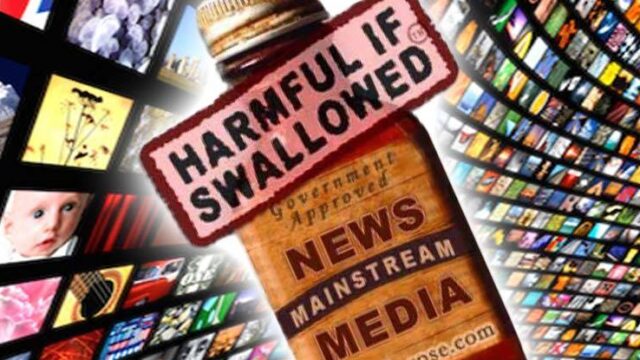The Perfidy of ’60 Minutes’

It is a truism, a trope, a meme, common knowledge, a cliché, as obvious as a nose on a face, an actual fact and something so apparent that it is impossible in any way, shape, or form to deny unless utterly delusional.
But, somehow, time and time again, the major media players defy actual reality and try and try to substitute their own absurd version and – even more incredibly, like a lunatic accusing the clouds in the sky of conspiring against him – demand everyone within earshot to believe that it is true.
Typically, pointing out media propaganda is the same as pointing out that air exists – it is an atmosphere that we all must breathe and is typically specifically unremarkable due to its omnipresence.
But sometimes, when it is so egregious, so absurd, so literally dangerous, it must be challenged.
Which brings us to Sunday’s episode of the once-vaunted, now vile 60 Minutes.
The show that once intentionally made bad actors deeply uncomfortable by asking difficult questions is a shadow of its former self, with its story on the National Institutes of Health (NIH) a perfect example of the depths to which it has fallen.
The NIH has a new director, Dr. Jay Bhattacharya. Even before he officially took over a few weeks ago, the Trump administration had already announced a few changes: dropping 1,200 probationary employees, putting new purchasing standards in place, and cutting the amount of “overhead” its research and academic “partners” can charge to conduct studies.
This, of course, led to much wailing and gnashing of teeth – not of course from the public, but from the staff, current, past, and future.
Breaking down the segment into its constituent parts, one finds three main points.
First, a grad student is worried she may not get a job because of the looming budget cuts.
Second, a woman in an Alzheimer’s research study worries she will be negatively impacted by the cuts.
These two bits are rather silly but very heartstring tuggy. In the case of the grad student, she’s complaining about what may or may not be, as if she were entitled to a position somewhere.
In the case of the Alzheimer’s patient, it is rather telling – and may even be terrifyingly true – that she is worried that the study she is part of may face an overhead cut.
As the show notes – moments after her worried statement – the NIH has cut the amount it pays for overhead – administrators, paper clips, etc. – to institutions from an overhead of about 28% to 15%.
Note – the cut is not for the research project itself, but just to the administrative overhead. Second note – the much-vaunted Bill & Melinda Gates Foundation (like almost every other funder of medical research) has always capped its overhead costs at 15%.
So, ironically, what the patient is – even if she does not know it – really worried about is whether or not the folks that run the study (being done by Duke University and UNC jointly) could actually prioritize paying administrators over caring for patients.
Come to think of it, she may have a point. The growth of the number of administrators in academia has been eye-popping. Take Harvard, for example:
At Harvard, administrative staff grew from 1,222 in 1969 to 6,543 in 2021, a 435% increase over five decades. The deep hilarity of this figure is that their undergraduate student population was 6,700 in 1969 and 7,153 in 2021. The ratio of admin to students rose from 1 per 5.5 (already absurd) to 1 per 1.1. We’re basically at the point of each student having their own administrator despite having moved from paper records to the internet age.
By the way, in that same time period the number of faculty members stayed the same as well.
And it is not just Harvard, obviously. Various “higher education news outlets” are lamenting the proposed cuts…which, again, are not cuts but simply bringing the NIH in line with industry standards. To be blunt, if you can make a grant from the Gates Foundation work on 15% overhead, why can’t you do the same with an NIH grant?
It is true that the NIH cuts would land hard for many…many administrators. That is:
For example, a 15% cap for indirect funding would mean a loss of $121 million at University of California, San Francisco, $136 million at Johns Hopkins University, $129 million at University of Pennsylvania and $119 million at University of Michigan. According to a New York Times analysis.
That, by the way, is about 2.600 administrative jobs. Heaven forfend.
But it is the third chunk of the piece de la subsistence involving former NIH head Dr. Frances Collins – you know, the guy who was technically in charge during the pandemic (technically because though he was Tiny Fauci’s boss, he would be better described as his pet) that is the most chilling.
Collins says (and 60 Minutes) “confirms” by talking to sad NIH bureaucrats who have never ever had to deal with concepts like justifying their work, that morale has plummeted, and the staff has actually been crying.
Collins talks about the good work the NIH has done – unquestionably true – but seems to imply quite strongly that it is the administrators of the actual scientists and researchers who deserve much of the credit for maintaining the world’s largest funder of medical research grants.
Beyond the pablum absurdities and the obvious bitterness of a man who jumped before he was pushed, Collins seems wistful for his time at the NIH, wistful for a time when experts like him were bowed down before.
And then we come to the invisible elephant in the room. At no time during the interview is Collins asked about the NIH response to Covid.
Not a peep, not a question – it’s as if it didn’t happen, even though Collins laments that even after Covid the public is unsure about what the NIH does.
Thought experiment:
Imagine if you will being a reporter and getting an interview with Mussolini in 1944.
At this point, his fascist regime has collapsed and he is holed up in the northern Italian city of Salo, “leading” the Nazi Germany puppet regime called the Italian Social Republic.
You go and do the interview, but the result seems off – purposefully off.
You don’t ask about fascism itself, you don’t ask about what’s going on now in Salo, and you do not discuss World War II.
And you allow Il Duce to wax poetic about how wonderful things used to be and even let him talk about how the Allies are doing a terrible job in the rest of the country because they just don’t “get” the culture of Italy.
And, again, unlike Basil Fawlty, you do not mention the war.
Collins’ exchange is even the odder because of previous statements he has made on the subject of the pandemic, essentially trying to say maybe kinda sorta that there were a few problems with communications and maybe just maybe his team should have possibly considered other factors when imposing lockdowns and such (though that admission was done in a rather humble-brag way as he tried to say the equivalent of how dare people try to put a price on a human life).
By the way, that is about as far as he got, though certain news stories offered him faint praise at the time for at least – unlike Fauci – seeming to be able to question his own actions.
Beyond his “limited hangout” regarding Covid, Collins offered at least one accidental moment of truth – no, not in the 60 Minutes bit but at the “Braver Angels” (see above) chat he had in late 2023.
When asked about the Great Barrington Declaration, which posited that Covid protections should be focused on the most vulnerable to avoid grinding society to a halt – Collins said he “regretted” using certain words like “fringe” to describe the position and the authors – Dr. Martin Kulldorff of Harvard, Dr. Sunetra Gupta of Oxford, and Bhattacharya himself (Stanford).
Collins also referenced an email he sent to his NIH, etc. colleagues when the Declaration was released, demanding a “quick and devastating public take down” of the proposal.
He implied that that may not have been the most sciency of ideas, but then – very tellingly – happily noted that within “14 days” of his call for a response a dozen or so major public health agencies did in fact release an actual “take down” – his words – of the Declaration.
That little admission is extremely telling as to where Collins actually stands to this day on the pandemic response.
The other little admission as to where the media actually stands on the pandemic response?
The 60 Minutes website clips of the Collins interview, etc., are all:
“Brought to you by Pfizer.”
